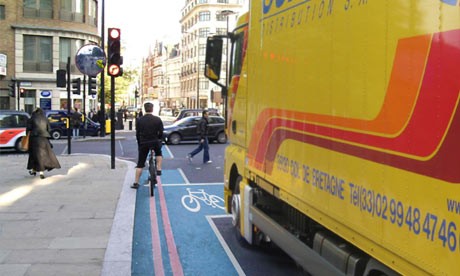
A new campaign calls for transport firms to send their HGV drivers on cycle-awareness courses and fit their vehicles with cameras
The risk to cyclists from large lorries is a problem in all urban areas. Thankfully crashes are rare – on average about eight cyclists per year are killed by lorries in London, accounting for about half the cyclist deaths in the capital. Across the UK, about 28 are killed by lorries each year, with 70% of these in urban areas.
But worryingly these accidents are always serious, and saturation media coverage of each one contributes greatly to the perception that cycling is much more risky than it is. The financial costs of such road fatalities are vast, too, estimated at over £1.6m per person, so there are compelling reasons to make prevention a priority before the terrible human cost of each crash has even been considered.
Lorries present a danger to cyclists in cities across the UK and Europe, but the figures are most clear in London, where they make up only a small proportion of traffic and are involved in less than 10% of cyclist crashes, yet account for about half of all cyclist fatalities.
Campaigners have persuaded Transport for London (TfL) to prioritise this problem as part of its Cycle Safety Action Plan. Two of TfL's most recent lorry safety measures involve installing 'Trixie' mirrors at the most hazardous junctions to help drivers see better, while the Freight Transport Association (FTA) is supporting some rescheduling of deliveries and improved training for drivers. This action is welcomed to some degree, but Trixie mirrors aren't proven to save lives, and there must also be enforcement against those rogue operators who put profits before lives by using sub-standard equipment and pressurising drivers.
The third of TfL's recent measures is a new poster showing an HGV with a dozen cyclists that are allegedly in the driver's blind spot. The poster places great emphasis on warning cyclists of danger, but fails to focus on what the driver should be doing.
Educating cyclists is sensible but educating drivers is much more effective because they're professionals, with a legal and moral responsibility to ensure the safety of all other road-users, even unskilled cyclists and unwary pedestrians.
So how can lorry drivers avoid killing cyclists and pedestrians? Well, the first thing is for them to expect more cyclists on the road around them. The most popular streets for cyclists, such as Hyde Park Corner and Clapham Road, now carry over 1,000 bikes per hour at peak times. New lorries have potentially life-saving extra mirrors to reduce hidden areas, and the best companies have installed nearside cameras and sensors to help drivers. All this kit should be standard.
It is essential that drivers keep constant watch while approaching junctions, noting where all the other road-users are, and whether any might be moving into a position where they can't be seen. It is not acceptable to blame a blind spot for causing a crash. If there is any doubt, the driver should assume a cyclist or pedestrian could be hidden from view and take the appropriate action.
Unusually among road-users, large lorries turn left from a position well forward of the junction, often a long way over to the right-hand side of their lane. If they perform this manoeuvre slowly and carefully, most cyclists will become visible in the mirrors, and the others will have time to move far enough in front to be seen. Turning carefully must be the highest priority for lorry drivers in cities.
These safe driving techniques aren't new, and many drivers use them all the time. New lorries are twice as powerful and much easier to handle than a generation ago, which means they can be very safe, but it also means that in the wrong hands they can be much more dangerous. All drivers need to be taught how to minimise the risks their lorries create.
Driver training and responsibility are two crucial elements of London Cycling Campaign's six-point No More Lethal Lorries campaign. We're calling on all companies to include cycle awareness in ongoing training for drivers. They should follow the example of London's Lambeth council, which has been asking its drivers to ride bicycles so they understand what it's like on the other side of the street. We've met lorry drivers who say they're too scared to cycle; how can that be acceptable when they have it in their hands to make the roads safer for all of us?
True, the examples above are in London, where the cycling boom has brought lorry fatalities into sharp focus, but the issues are the same across the UK; indeed, the same driver and vehicle can be in Birmingham or Glasgow just a few hours after they have left the capital.
Across the whole country there needs to be a dramatic change in the culture that accepts poor driving as an excuse for road fatalities and serious injuries. The more large and lethal the vehicle you choose to drive, the more responsibility you must shoulder. If this simple fact were engrained throughout society – from the Highway Code, to the police, the CPS, the judiciary, all the way through to insurance pay-outs – then what a safer, more sane, place we would live in.
• Charlie Lloyd is a former lorry driver who works for the London Cycling Campaign
From guardian.co.uk
